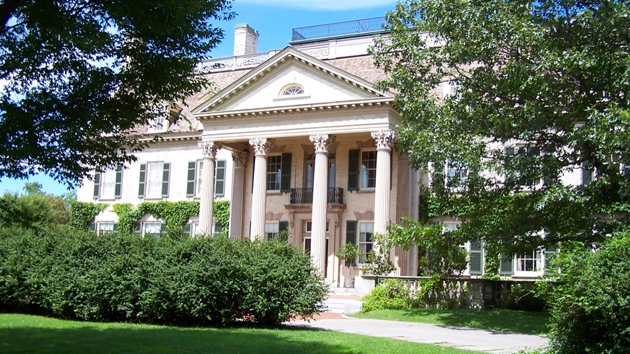Itching to work among some 400,000 photographs and negatives dating back to photography's earliest experiments and still and film cameras from every era? Want to help protect and grow a collection of some 23,000 films and several million film stills from the likes of Technicolor, Spike Lee and Martin Scorsese? Is the digital future squarely in your field of view but a scholarly interest in preservation in your blood? I may have an opening for you.
The George Eastman House in Rochester, N.Y., is looking for a talented filmmaker/curator/preservationist to direct its world-class museum and archive. (At last look, the museum is also advertising for a Web developer/manager of the collection's digital assets.)
Eastman's 1905 house (above), where the museum is located, is also something of an early monument to technology: behind its elegant stone columns lie early examples of an electrical generator, a 21-station telephone system, a built-in vacuum cleaning system, a central clock network and an elevator. George Eastman House also runs the nearby Louis B. Mayer Conservation Center (only one of a handful in the U.S.), which stores rare 35 mm prints made on cellulose nitrate.
The downside? If you are not a fan of wind and snow, a full-time residency in upstate New York may not be for you. (To put it in perspective, Rochester sits equidistant between Syracuse and Buffalo, below Lake Ontario, and typically wins the title of "Golden Snowball" among those neighbors for its record snowfalls each winter.) You'll also have a tough act to follow. The museum's retiring director, filmmaker and curator Tony Bannon, is credited with increasing the museum's international profile and bringing it into the digital era. The 69-year-old Bannon, who will be honored at a gala on May 12, says it is "time for new energy and vision to move" the museum's "vigorous" strategic direction forward. During his tenure, Bannon acquired the archives of Technicolor, Merchant Ivory Productions (2600 elements in all) and notable films from Ken Burns, Spike Lee and Martin Scorsese. He developed the first permanent school of film preservation, the L. Jeffrey Selznick School of Film Preservation, with the University of Rochester. The program offers both one-year certificates and two-year master's level degrees in film preservation techniques.
Then there is that unavoidable association with Kodak, the company George Eastman founded. Although the George Eastman House is an independent institution run by a board of trustees (before WWII, it was owned by the University of Rochester), Kodak has been a major museum partner since the museum first opened its doors to the public in 1949. The company also helped establish Eastman House's state-of-the-art archive facilities during the mid-1980s. Kodak's $17 million donation, plus the public's $12.5 donation, built a 73,000-square-foot, subterranean, climate-controlled vault, research and gallery space, much of which now sits beneath the estate's restored gardens. Gifts of that size won't be coming from Kodak or its successors any time soon.
But it's not all bad news for Eastman House's neighbors. Actually, the city of Rochester has been in growth mode in the past year, despite Kodak's downward spiral. Thanks to the University of Rochester and the Rochester Institute of Technology—and all those talented, out-of-work Kodak employees—the city is experiencing a modest high-tech medical and optics boom. The George Eastman House feels similarly upbeat. The museum says clearly on its Web site that it hopes to partner once again with Kodak after it has emerged from its expected "transformation into a streamlined company that intends to continue close ties to the community."
For a scroll through more interesting recent job openings, visit the StudioDaily Job Boards here.
Did you enjoy this article? Sign up to receive the StudioDaily Fix eletter containing the latest stories, including news, videos, interviews, reviews and more.

